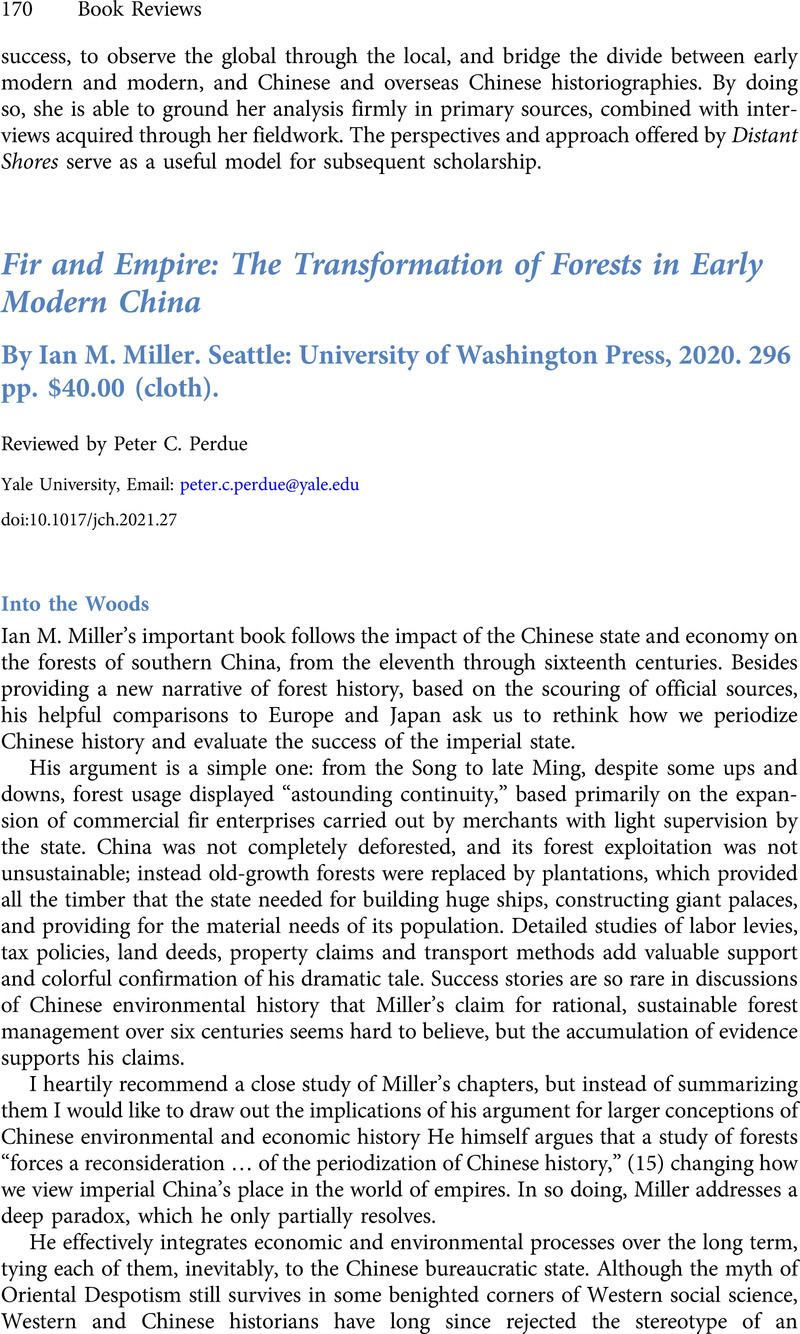No CrossRef data available.
Article contents
Fir and Empire: The Transformation of Forests in Early Modern China By Ian M. Miller. Seattle: University of Washington Press, 2020. 296 pp. $40.00 (cloth).
Review products
Published online by Cambridge University Press: 21 December 2021
Abstract

- Type
- Book Review
- Information
- Copyright
- Copyright © The Author(s), 2021. Published by Cambridge University Press
References
1 Acemoglu, Daron and Robinson, James A., The Narrow Corridor : States, Societies, and the Fate of Liberty (New York: Penguin Press, 2019)Google Scholar; Ruskola, Teemu, Legal Orientalism: China, the United States, and Modern Law (Cambridge, MA: Harvard University Press, 2013)CrossRefGoogle Scholar.
2 Pomeranz, Kenneth, The Great Divergence: China, Europe, and the Making of the Modern World Economy (Princeton: Princeton University Press, 2000)CrossRefGoogle Scholar; Glahn, Richard von, The Economic History of China from Antiquity to the Nineteenth Century (Cambridge: Cambridge University Press, 2016)CrossRefGoogle Scholar.
3 Mark Elvin and Liu Ts'ui-jung, eds. (1995). Sediments of Time: Environment and Society in Chinese History (Cambridge: Cambridge University Press, 1995); Elvin, Mark, The Retreat of the Elephants: An Environmental History of China (New Haven: Yale University Press, 2004)Google Scholar; Marks, Robert B., China: Its Environment and History (Lanham: Rowman & Littlefield, 2012)Google Scholar.
4 Ruth Mostern, Yu's Traces: Five Thousand Years of Sediment and Society Along China's Yellow River (New Haven: Yale University Press, forthcoming); Smith, Paul Jakov, Taxing Heaven's Storehouse: Horses, Bureaucrats, and the Destruction of the Sichuan Tea Industry, 1074–1224. (Cambridge, MA: Harvard University Press, 1991)Google Scholar.
5 Zhang, Ling, The River, the Plain, and the State: An Environmental Drama in Northern Song China, 1048–1128. (Cambridge: Cambridge University Press, 2016)CrossRefGoogle Scholar.
6 Yuan Julian Chen, “The Environmental Footprint of China's Song Dynasty Capital Kaifeng, 960–1127” (PhD diss., Yale, 2020).
7 Woodside, Alexander B., Lost Modernities: China, Vietnam, Korea, and the Hazards of World History (Cambridge, MA: Harvard University Press, 2006)CrossRefGoogle Scholar.
8 Meng, Zhang, “Financing Market-Oriented Reforestation: Securitization of Timberlands and Shareholding Practices in Southwest China, 1750–1900.” Late Imperial China 39.9 (2017), 109–51Google Scholar.
9 Perdue, Peter C., Exhausting the Earth: State and Peasant in Hunan, 1500–1850 (Cambridge, MA: Harvard University Press, 1987)Google Scholar; Schoppa, Keith, Song Full of Tears: Nine Centuries of Chinese Life Around Xiang Lake (Boulder: Westview Press, 2002)Google Scholar.
10 Bian, He, Know your Remedies: Pharmacy and Culture In Early Modern China. (Princeton: Princeton University Press, 2020)Google Scholar.





